- News
- Finds
- History
- Holidays
- Arch'gy
- Exporting
- Treasure
- Awards
- Tips
- Comps
- Forum
- Club info
- Contact
 |
Metal detecting holidays in England with the Worlds most successful metal detecting club Twinned with Midwest Historical Research Society USA |
 |
Metal detecting holidays in England with the Worlds most successful metal detecting club Twinned with Midwest Historical Research Society USA |
2010 Oct finds page |
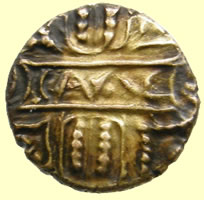 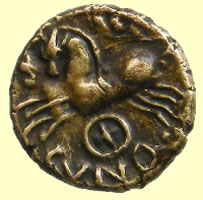 |
|||||||||||||||
Celtic gold qtr stater Cunobelin biga type 10 to 40 AD Sent to CCI for recording 1.36g, 10.93mm |
|||||||||||||||
|
|||||||||||||||
11,000 BC stone age axe head 125.18mm L x 51.60mm W x 26.01mm T |
|||||||||||||||
 |
 |
  |
|||||||||||||
17thC Charles II silver button - reported the museum as treasure |
15thC lead token |
1247 Henry III hammered silver voided half penny- Class II or III Obv HENRICVS REX Rev - ***/ARD/ONL/*** - Moneyer Richard of Lincoln |
|||||||||||||
  |
 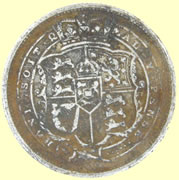 |
||||||||||||||
1487-9 Henry VII hammered silver halfpenny - Rose mintmark - crosses by neck - open crown Type 1C Obv HENRIC DI GRA REX - colon stops to end of legend
Rev CIVI/TAS/LON/DON - London mint 12.85mm,0.41g |
1819 George III milled silver shilling (12 pence) |
||||||||||||||
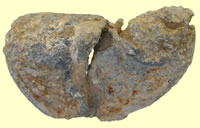 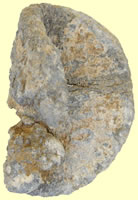  |
|||||||||||||||
Medieval lead papel badge |
|||||||||||||||
 |
 |
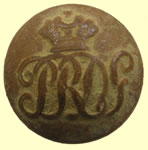 |
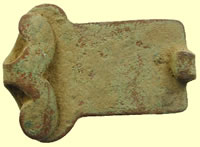 |
||||||||||||
|
|
1855- 1930 Princess Royal 7th Dragoon guards button |
18thC clog fastener |
||||||||||||
 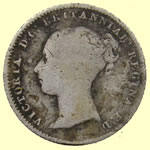 |
  |
||||||||||||||
1849 Victoria milled silver groat (4 pence) |
Post medeival lead bale seal |
||||||||||||||
  |
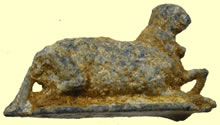 |
||||||||||||||
Roman bronze cotter pin |
This lead figurine looks very old and the animal is a strange beast - one for the museum to look at |
||||||||||||||
 |
 |
||||||||||||||
1930's safety razor handle ? |
Interesting jewelry clasp with arabic type inscription |
||||||||||||||
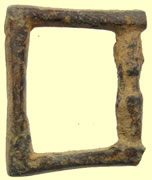 |
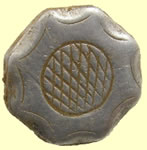 |
 |
|||||||||||||
Medieval buckle |
18thC silver button |
Medieval lead coin weight |
|||||||||||||
|
|||||||||||||||
1917 Chester hallmarked 18 carat gold ring with diamond maker W&H Ld William Hutchinson Assay Office Chester |
|||||||||||||||
 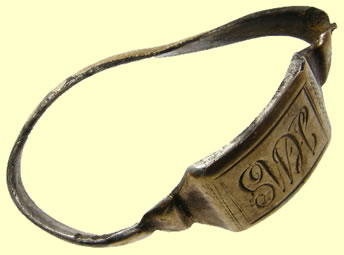 |
|||||||||||||||
Georgian gold on silver signet ring - no hall marks |
|||||||||||||||
13thc Vessica seal matrix - Sacificial lamb of god - ECCEAG NVS DEI |
|||||||||||||||
Huge Medeival cloisonné enamel-work mount |
|||||||||||||||
1723 George 1st milled silver shilling - SSC first bust |
|||||||||||||||
  |
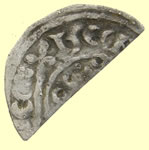  |
||||||||||||||
1247 Henry III hammered silver voided half penny DAV/ION/LVN/DEN - Moneyer Davi of London mint |
1217-1242 Henry III hammered silver short cross half penny - Class 7b Moneyer Ilger of London mint |
||||||||||||||
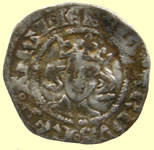 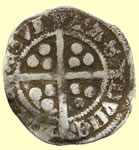 |
  |
||||||||||||||
1351 -1352 Edward III hammered silver penny - Cross 1 - Pre treaty Series C Obv EDWARDVS REX ANGLI Rev CIVI/TAS/DVNE/LIME - Durham mint |
1856 Victorian milled silver sixpence |
||||||||||||||
 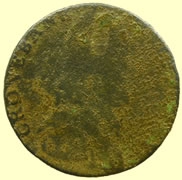 |
  |
||||||||||||||
1789 Irish miners Conder half penny OBVERSE: A bishop's head in profile. CRONEBANE HALFPENNY. Without Crosier. No period. REVERSE: ASSOCIATED IRISH MINERS ARMS dated 1789. Crest has windlass, shovels, picks, etc. EDGE: PAYABLE IN LANCASTER LONDON OR BRISTOL
|
1907 Edward VII milled silver sixpence |
||||||||||||||
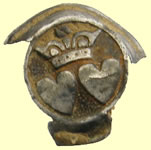 |
  |
||||||||||||||
17thC Charles II silver button - reported the museum as treasure |
1217/8 Henry III hammered silver short cross half penny - Class 6d Rev *NTE + TOM - Moneyer Thomas of Canerbury |
||||||||||||||
  |
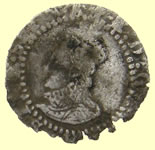  |
||||||||||||||
Not sure of the date of this silver brooch with gold eyes but it's construction could be 16thC Tudor - reported to museum as potential treasure |
1580-1 Elizabeth 1st hammered silver penny - 5th issue latin cross mintmark |
||||||||||||||
  |
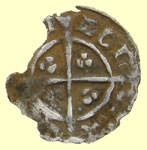 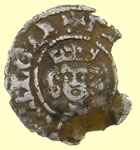 |
||||||||||||||
1573-8 Elizabeth 1st hammered silver 3 pence - Eglantine mintmark |
1377 Richard II hammered silver half penny- Type 3 OBV +RICARDxREXx:ANGL Rev CIVI/TAS/LON/DON - London mint |
||||||||||||||
  |
  |
||||||||||||||
Roman Faustina II - wife of Marcus Aurelius (161-180 AD) |
Mid 4thC House of Constantine Roman bronze coin |
||||||||||||||
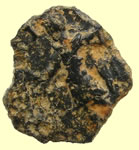  |
  |
||||||||||||||
Mid 4thC House of Constantine Roman bronze coin |
2nd C Roman bronze sent for ID What you have here is an early-issue As of Hadrian (I assume it's an As, based on your size-description) Even though I can't guarantee I'm quoting you the entire set of legends verbatim, the bust-type is the one Hadrian used at the beginning of his reign - c. 117-122, so the obverse legend should be IMP CAESAR TRAIANVS HADRIANVS AVG. and the "...NVS...", visible at 12:00 obverse, fits with that legend-type and the long-chested (short bearded) busts of this era.
The reverse type is Fortuna Redux seated left, holding rudder and cornucopiae, and probably has for its circumferential legend PONT MAX TR POT COS III; S - C - and, as you can clearly read, FORT[una] RED[ux] in the exergue.
According to RIC vol II (not the most up-to-date reference at the moment, and in the process of being re-written), the only time an As of this type occured in the series was c. 120-122, # 578. It's a common type recurring almost yearly on both sestertii and dupondii, but since this is the only mention of an As for this type, that's the only reason I can give you such a presumably accurate date and details of the parts you can't see or read on this coin.
Mark
|
||||||||||||||
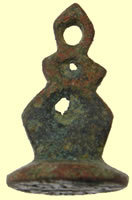 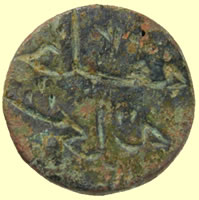 |
|||||||||||||||
Not sure on this early seal matrix as the lettering is North Afican or Asian - does anyone know what is means >- one for the museum
|
|||||||||||||||
Victorian gold pendant found by Org Eric |
|||||||||||||||
Monster relic - 4thC Roman gold coin contemporary forgery 1.28g, 17.59mm This coin has a Shewolf & Twins reverse which is typically found on the VRBS ROMA, City of Rome commemorative, reduced-module folles introduced around 330 AD., at the time Constantinople became the official seat of Constantine's government. These have a helmeted and mantled bust of the allegorical personification of the City of Rome facing left on their obverses. Mark Lehman That's a very interesting piece - however, even though counterfeits came into existence about 3 hours after coins were invented, this isn't a counterfeit. It's not an ancient forgery or counterfeit made to deceive, at any rate. It's also not an "official forgery" (like the plated Athenian Owls) and is unlikely to be a simple contemporary copy with some local, semi-legitimacy, because there simply was no gold coin of this type.
Typically, fourres of Roman gold coins date to a somewhat earlier time - primarily the 1st century - I don't think gold circulated much after that time. It was used as a store of value or for major transactions like land purchases, but people weren't carrying it around as a regular thing in the 4th century. The fact that almost all the gold of this era ever found is virtually uncirculated attests to the lack of circulation. Those 1st century BC & AD fourres were typically made by wrapping a base (generally copper) core with a fairly thick foil of silver (the vast majority of fourres are silver) or gold which was "soldered" to the core by introducing a layer of a powdered flux and heating the resulting blanks before striking. Except when the die-sinking was so amateurish that it's impossible to miss, or the core becomes exposed, these are fairly believable - except that their weight is generally low for the type. However, this expensive, labor-intensive foil-wrap technique had gone just about totally out of existence in the late 2nd, early 3rd century, since the silver it was made to copy had become so debased that the official "silver" itself had to resort to surface-enrichment techniques to pass for silver. Those same techniques were a lot cheaper and easier for the forgers, too, so you find "silvered" fourres beginning at this time.
However, this appears to have been plated by electrolysis (possibly a pre-electric, strictly chemical process) or some other type of plating, rather than wrapping or selective reduction (surface enrichment) technology. It's obviously been buried a while - the edge-chipping seems consistent with contemporary types you find (these date to the period 330-340) and the host coin appears to be a completely legitimate piece - RIC VII 561 from Trier. This puts it in an "after-market plating" situation. And the reasons people plate coins are numerous, and being personal, are seldom easily explained. This doesn't seem, strictly speaking, to be a "modern" plating job (post 1500), but it really could have been done at any time and for any reason - except to be a "counterfeit" by the strict definition of a counterfeit.
The VRBS ROMA / shewolf & twins reduced folles were silvered when issued - although the silvery coating seldom survives to the present day. We nevertheless need to be sure this isn't discolored silvering. If it was definitely an applied, "golden" coating (gold or otherwise), it could have been done at any time.
Mark
|
|||||||||||||||
  |
 |
 |
|||||||||||||
Victorian silver ring - part makers mark showing |
15thC leasd token - type 2 |
15thC lead token |
|||||||||||||
 |
 |
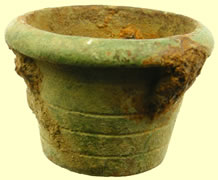 |
|||||||||||||
Georgian buckle |
15thC lead token |
18thC bullion cup weight - outside weight set with handle locations |
|||||||||||||
 |
|||||||||||||||
18thC decorated ramrod guide
|
|||||||||||||||
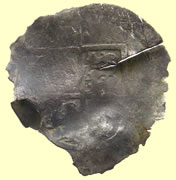 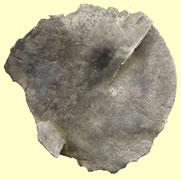 |
 |
 |
|||||||||||||
1554 Mary hammered silver groat |
19thC livery button |
16thC clothing fastener |
|||||||||||||
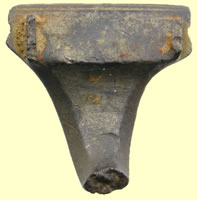 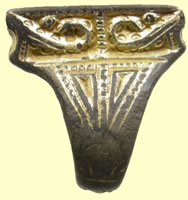 |
|||||||||||||||
Saxon gilded silver T brooch ? The serpent design is typically Saxon, is it a modern copy ? - reported to museum as possible treasure
|
|||||||||||||||
C10thC Saxon fretwork strap end - 39.19mm L x 20.90mm W |
|||||||||||||||
 |
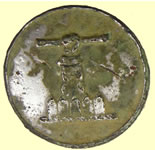 |
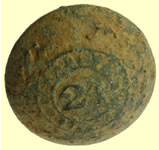 |
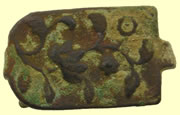 |
||||||||||||
Navy button HONI SOIT QUI MAN Y PENSE PACKET Honi soit qui mal y pense (Old French: shame upon him who thinks evil of it) RN - Packet Service c.1800-1811 |
19thC livery button |
19thC 24th Regiment of foot button |
18thC clog fastener |
||||||||||||
 |
 |
 |
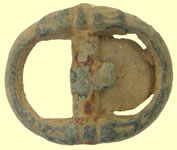 |
||||||||||||
Royal Marines button |
19thC silver thimble |
1550-1650 buckle |
1600-1720 buckle |
||||||||||||
 |
 |
  |
|||||||||||||
Royal Air force cap badge |
Roman bronze mount |
Post medieval lead Belgium bale seal |
|||||||||||||
 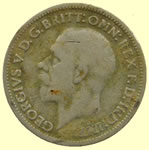 |
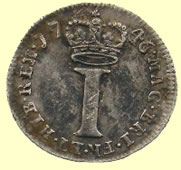 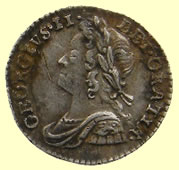 |
||||||||||||||
1931 George V milled silver sixpence |
1746 George II milled silver penny |
||||||||||||||
  |
 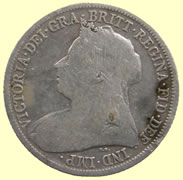 |
||||||||||||||
1696 Willliam III milled silver sixpence - Coventry mint |
1901 Victoria milled silver shilling (12 pence) |
||||||||||||||
 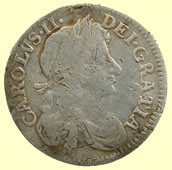 |
  |
||||||||||||||
1684 Charles II milled silver 4 pence |
1781 Friedrich II milled silver 1 Schilling German State of Mecklenburg-Schwerin |
||||||||||||||
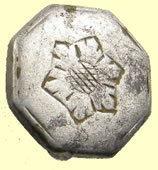 |
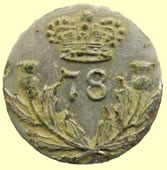 |
  |
|||||||||||||
18thC silver button |
|
1877 Victoria milled silver sixpence |
|||||||||||||
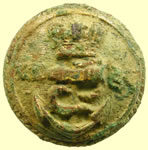 |
 |
 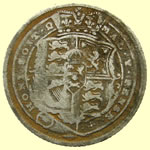 |
|||||||||||||
Royal Navy - Officers (Roped Rim) Lined Background 17.5mm - 1843-1891
|
15thC lead token |
1817 George III milled silver sixpence |
|||||||||||||
 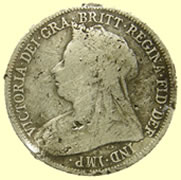 |
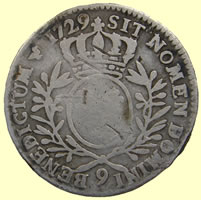  |
||||||||||||||
1898 Victoria milled silver shilling (12 pence) |
1729 French Louis XV milled silver - 1/2 ECU (44 Sols) 13.98g, 32.75mm |
||||||||||||||
Part 'cooked' Roman silver coin straight into the 'cooker' to remove the 'crust' |
|||||||||||||||
  |
 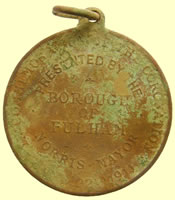 |
||||||||||||||
1696 William III milled silver sixpence |
1911 George V medallion - Presented by Norris the Mayor of Fulham borough |
||||||||||||||
 |
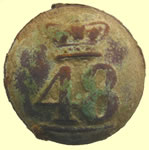 |
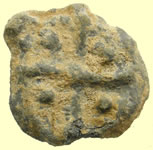 |
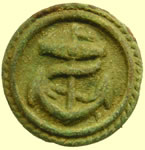 |
||||||||||||
18thC toy cannon |
|
15thC lead token - type 2 |
RN Capt / Commander - 1774 Var. 03 . . . 1774 - 1787 In use 1774 - 1787 |
||||||||||||
 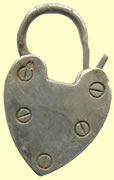 |
 |
||||||||||||||
Victorian silver padlock |
16thC serpent buckle |
||||||||||||||
  |
 |
||||||||||||||
Medieval hammered silver penny Rev CIVI/TAS/LON/DON |
18thC bell clapper |
||||||||||||||
 |
 |
 |
|||||||||||||
16thC Tudor button |
Essex regiment cap badge |
Interesting key ? |
|||||||||||||
  |
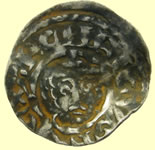 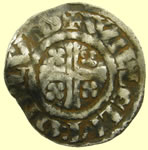 |
||||||||||||||
17thC mount with black stone |
1190-1194 AD Richard 1st hammered silver shortcross penny - Class 3 Obv - HENRICVS REX Rev WILLELM.ON.LVD - Moneyer Willelm of London mint 1.33g, 19.94mm |
||||||||||||||
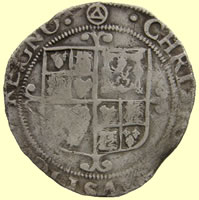 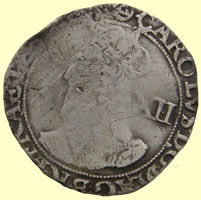 |
|||||||||||||||
1639-40 Charles 1st hammered silver shilling (12 pence) - Tower mint under Charles - Triangle mintmark |
|||||||||||||||
 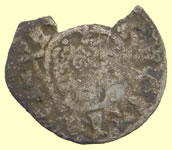 |
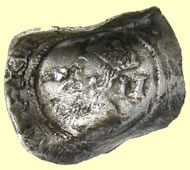 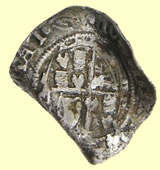 |
||||||||||||||
1215 Henry III hammered silver shortcross penny - Class 7b Obv - HENRICVS REX |
1645 Charles 1st hammered silver half groat (2 pence) Tower mint under Charles - Eye mintmark |
||||||||||||||
 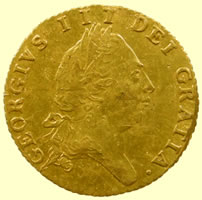 |
|||||||||||||||
1787 George III milled gold half guinea |
|||||||||||||||
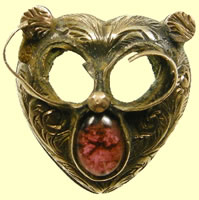 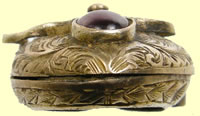 |
|||||||||||||||
Decorated gold locket with red stone - reported as possible treasure to museum |
|||||||||||||||
   |
|||||||||||||||
c13thC Medieval seal matrix - impression appears to be mythical beast |
|||||||||||||||
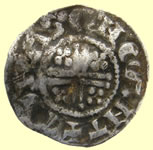 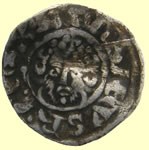 |
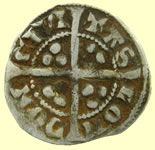 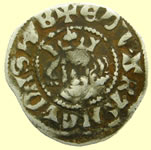 |
||||||||||||||
1217/8 Henry III hammered silver penny - Class 6d Obv HENRICVS REX Rev TOMAS.ON.CANT - Moneyer Tomas of Canterbury mint |
1341 Edward III hammered silver florin penny Obv EDWAR ANGL DNS HYB Rev CIVI/TAS/LON/DON - London mint |
||||||||||||||
 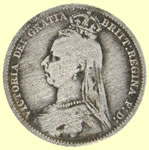 |
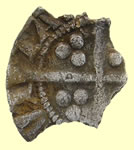 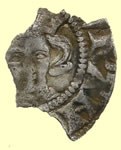 |
||||||||||||||
1891 Victoria milled silver sixpence |
|||||||||||||||
 |
 |
1341 Edward III hammered silver florin penny Obv **WR AN *** - Rev ** VI/TA** Civitas coin |
|||||||||||||
15thC lead token |
Georgian button |
||||||||||||||
 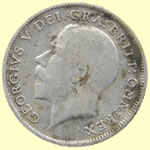 |
 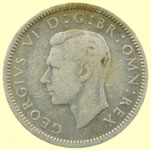 |
||||||||||||||
1913 George V milled silver sixpence |
1939 George VI milled silver sixpence |
||||||||||||||
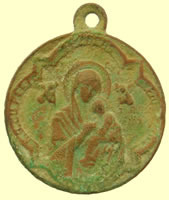 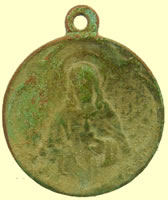 |
 |
 |
|||||||||||||
Religious medallion |
Georgian button |
19thC livery button |
|||||||||||||
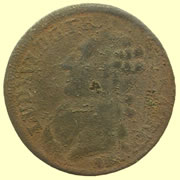 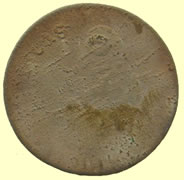 |
|||||||||||||||
French King Louis XVI (b1765-d1793) copper coin . His bust is encircled by the Latin legend LUD-XVI-D-G FR-ET-NAV-REX (Louis XVI, King of France and Navarre |
|||||||||||||||
  |
|||||||||||||||
Unknown hammered silver penny - Rampant Lion in shiled which should make it Scottish, voided long cross making it around 1247, cross type 3 in quadrants on reverse, initial mark cross type 3 like an Edward III. Facinating coin I will be researching more |
|||||||||||||||
 |
 |
  |
|||||||||||||
Medieval gilded hooked mount - 2 rivet fixings |
Medieval pot leg |
134AD Hadrian roman bronze coin |
|||||||||||||
 |
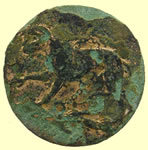 |
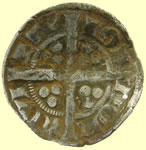  |
|||||||||||||
Medieval lead coin weight |
19thC livery button |
1341 Edward III hammered silver florin penny Obv EDWAR R ANGL DNS HYB Rev CIVI/TAS/LON/DON - London mint |
|||||||||||||
  |
 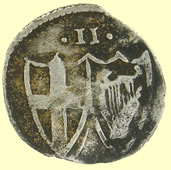 |
||||||||||||||
1560-1 Elizabeth 1st hammered silver half groat (2 pence) - Marlet mint mark
|
1649 Commonwealth hammered silver half groat (2 pence) |
||||||||||||||
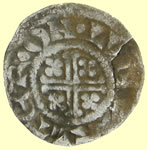  |
|
||||||||||||||
1204/5 King John hammered silver shortcross penny - Class 5c Obv HENRICVS REX Rev WALTER .ON.LVD |
Georgian gold watch winder |
||||||||||||||
 |
 |
 |
|||||||||||||
Medeival lead gaming piece |
Georgian silver thimble |
Curios silver hall mark not in book ? 3 turrets of Newcastle ? |
|||||||||||||
 |
 |
  |
|||||||||||||
Georgian harness mount |
18thC bayonet frog |
Cast copper alloy mount of probable late medieval or post medieval date (1400-1600). |
|||||||||||||
  |
  |
||||||||||||||
Harness mount Date from: AD 1540 |
1653 Jeremy Erds of Manningtree Essex hammered copper trade farthing |
||||||||||||||
c13thC Medieval seal matrix - sacrificial lamb type |
|||||||||||||||
 |
 |
||||||||||||||
1915 Silver cane band - London hall mark - date letter U |
18thC silver button |
||||||||||||||
 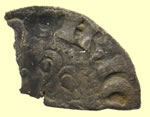 |
 |
||||||||||||||
1247 Henry III hammered silver voided long cross halfpenny |
Medieval (1250-1500) cast copper alloy bar mount |
||||||||||||||
  |
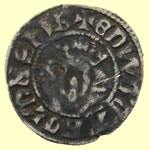 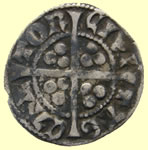 |
||||||||||||||
1667 Richard Barrell, Grocer of Hadleigh Suffolk hammered copper trade farthing |
1341 Edward III hammered silver penny - die error Obv EDWR C ANGL DNS HYB Rev CIVI/TAS/CAN/TOR - Canterbury mint |
||||||||||||||
  |
  |
||||||||||||||
1642 Charles 1st hammered silver penny- Shrewsbury mint |
Medeival hammered silver longcross penny |
||||||||||||||
  |
  |
||||||||||||||
Late medeival silver mount - reported to museum as treasure |
Facinating coin find - Tudor period copper coin when no copper coins were produced. Possible Elizabeth 1st hammered silver half groat forgery ? |
||||||||||||||
  |
  |
||||||||||||||
1582-4 Elizabeth 1st hammered silver half groat (2 pence) - A mintmark |
1356-1357 Edward III hammered silver half groat - Pre treaty Series Ga Annulet between pellets under POSV on reverse Obv EDWARDVS REX ANGL FRAN Rev CIVI/TAS/LON/DON - London mint |
||||||||||||||
  |
|||||||||||||||
11,000 BC flint axe head |
|||||||||||||||
 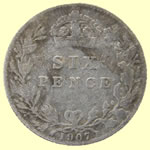 |
  |
||||||||||||||
1907 Edward VII milled silver sixpence |
Cast copper alloy mount of probable late medieval or post medieval date (1400-1600). |
||||||||||||||
  |
 |
||||||||||||||
1634 Charles 1st hammered copper rose farthing |
Royal Army mediecal corp cap badge |
||||||||||||||
|
|||||||||||||||
Large lead arm from a figurine |
|||||||||||||||
  |
 |
 |
|||||||||||||
1500-1700 mount |
15thC lead token - type 2 |
Georgian watch winder |
|||||||||||||
 |
 |
  |
|||||||||||||
15thC lead token - type 2 |
1550-1650 buckle |
13thC hammered silver shortcross cut halfpenny |
|||||||||||||
 |
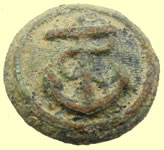 |
 |
 |
||||||||||||
Royal Marines button |
RN Capt / Commander - 1774 Var. 03 . . . 1774 - 1787 In use 1774 - 1787 |
17thC lead token |
16thC Tudor S buckle |
||||||||||||
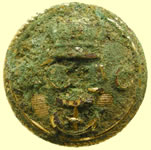 |
 |
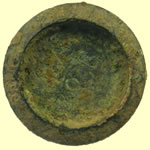 |
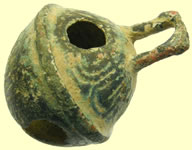 |
||||||||||||
UNITED KINGDOM
Royal London Yacht Club R. T. Y. C. - R. T. Y. C. London, England In use 1837 - 1901 |
Britain's Merchant Navy
Generic Design Issue In use 1900 's onwards |
Victorian 1/2 oz trade weight |
17thC decorated crotal bell |
||||||||||||
  |
|||||||||||||||
Harness ring or terret ring from the late Iron Age Broad period: IRON AGE Date from: Circa 300 BC |
|||||||||||||||
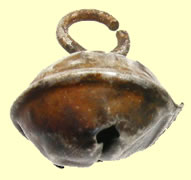 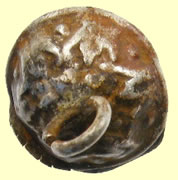 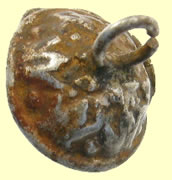 |
|||||||||||||||
Superb decorated medieval hawking bell - reported as treasure to the museum |
|||||||||||||||
|
 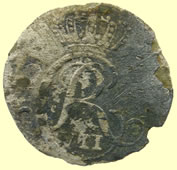 |
||||||||||||||
Medieval strapend |
1801 Danish 2 skilling silver coin |
||||||||||||||
  |
 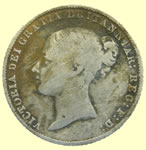 |
||||||||||||||
1606-7 James 1st hammered silver one pence - Escallop mint mark |
1866 Victoria milled silver sixpence |
||||||||||||||
 |
 |
  |
|||||||||||||
18thC silver button |
15thC lead token |
1350-1500 Medieval French coin weight - unrecorded - similar design to the parisis d'or of Philip IV |
|||||||||||||
  |
 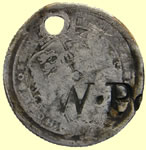 |
||||||||||||||
1592-5 Elizabeth 1st hammered silver penny -Tun mintmark |
Unusual love token - 1818 George III milled silver sixpence - stamped WP |
||||||||||||||
  |
 |
 |
|||||||||||||
1544 Henry VIII hammered silver groat (4 pence) |
15thC lead token |
Georgian silver fob seal hanger |
|||||||||||||
  |
 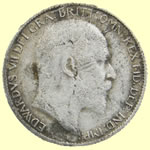 |
||||||||||||||
1696 William III milled silver sixpence |
1909 Edward VII milled silver sixpence |
||||||||||||||
  |
|||||||||||||||
1504-7 Henry VII hammed silver groat - Cosslet mint mark - Regular profile issue. Three bands to crown, hair to shoulders |
|||||||||||||||
1718 George 1st milled silver shilling (12 pence) |
|||||||||||||||
  |
 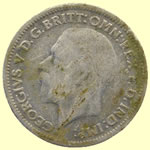 |
||||||||||||||
1582-4 Elizabeth 1st hammered silver half groat (2 pence) - A mintmark |
1935 George V milled silver sixpence |
||||||||||||||
  |
  |
||||||||||||||
Taco'd 1216 Henry III shortcross hammered silver penny - Class 7b Rev +GIFFREI.ON.LVD - Moneyer Giffrei of London mint |
1582-3 Elizabeth 1st hammered silver half groat (2 pence) - Bell mintmark |
||||||||||||||
 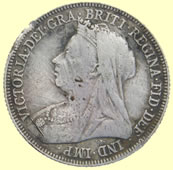 |
  |
||||||||||||||
1893 Victoria milled silver shilling |
1793 Suffolk Sudbury Halfpenny Condor OBVERSE: Shield of Arms of Sudbury; dog, lion. MAY THE TRADE OF SUDBURY FLOURISH. REVERSE: PRO BONO PUBLICO 1793. EDGE: PAYABLE AT GOLDSMITH & SONS SUDBURY .XXX. |
||||||||||||||
 |
 |
|
|||||||||||||
19thC livery button |
Silver thistle - possible Scottish regiment badge |
1897 Birmingham - Silver initialed brooch - 'MIZPAH' Marker Sydenham Bros Mizpah (emotional bond), an emotional bond between people who are separated |
|||||||||||||
 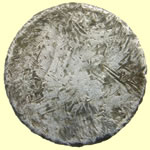 |
  |
||||||||||||||
1816 George III milled silver sixpence |
1882 French 5 centimes copper coin |
||||||||||||||
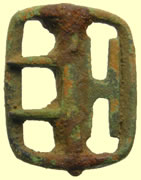 |
 |
 |
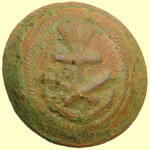 |
||||||||||||
19thC buckle |
Georgian button |
|
|
||||||||||||
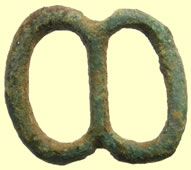 |
 |
 |
 |
||||||||||||
1550-1650 buckle |
WWII Air raid police button |
19thC horse harness bell |
1795 Royal artillery |
||||||||||||
More finds posted on 2010 Sept finds page More finds posted on 2010 Oct finds page II |
|||||||||||||||
 |
|||||||||||||||